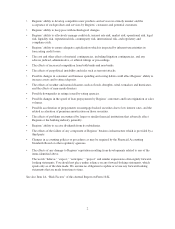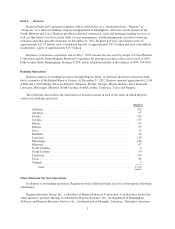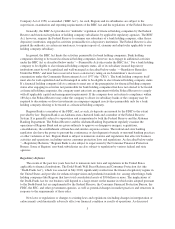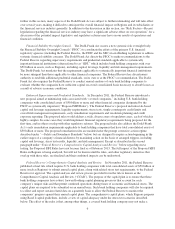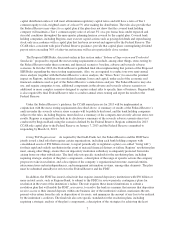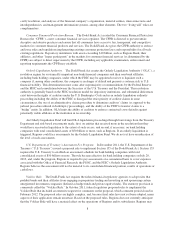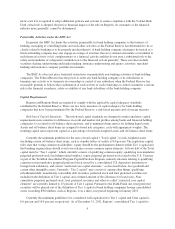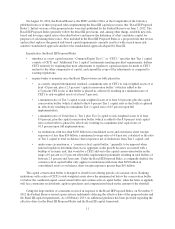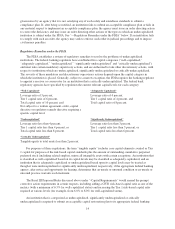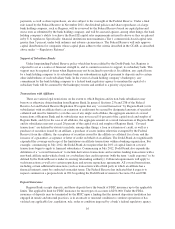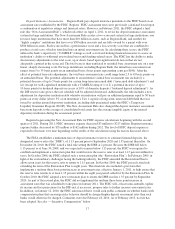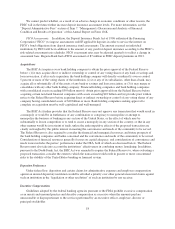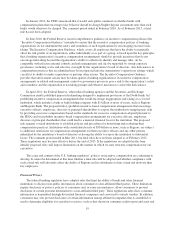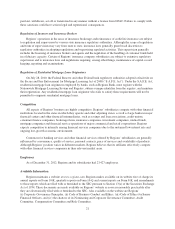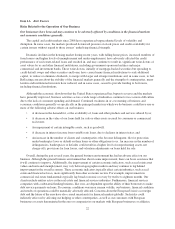Regions Bank 2012 Annual Report Download - page 28
Download and view the complete annual report
Please find page 28 of the 2012 Regions Bank annual report below. You can navigate through the pages in the report by either clicking on the pages listed below, or by using the keyword search tool below to find specific information within the annual report.In July 2011, the Basel Committee introduced a consultative document establishing a requirement for a
capital surcharge on certain globally systemically important banks (“G-SIBs”), and in November 2011, the Basel
Committee issued final provisions substantially unchanged from the previous proposal. An “indicator-based
approach” will be used to determine whether a bank is a G-SIB and the appropriate level of the surcharge to be
applied. The “indicator-based approach” consists of five broad categories: size, interconnectedness, lack of
substitutability, cross-jurisdictional activity and complexity. Under Basel III, banks found to be G-SIBs will be
subject to a progressive CET1 surcharge ranging from 1% to 3.5% over the Basel III 7% CET1 requirement. The
Basel III Proposed Rules do not address this surcharge although the U.S. bank regulatory agencies indicated in
the proposed rules that they plan to implement a surcharge for all, or a portion, of the banks with $50 billion or
more in consolidated assets, based on the approach taken by the Basel Committee. The surcharge was originally
intended to become fully effective on January 1, 2019. Regions is not currently subject to this CET1 surcharge.
However, it is possible that regional banking organizations may be subject to CET1 or other surcharges in the
future.
The Basel III Proposed Rules contemplated that the Basel III final framework would become effective
January 1, 2013, with the full requirements being phased in over a number of years. Under the proposed rules,
banking institutions initially would be required to meet the following minimum capital ratios:
• 3.5 percent CET1 to risk-weighted assets;
• 4.5 percent Tier 1 capital to risk-weighted assets; and
• 8.0 percent Total capital to risk-weighted assets.
Because the Federal Reserve has delayed indefinitely the effective date of the Basel III Proposed Rules, these
minimum capital ratios are not currently in effect.
The Basel III final framework provides for a number of new deductions from and adjustments to CET1,
such as the requirement that mortgage servicing rights, deferred tax assets and significant investments in non-
consolidated financial entities be deducted from CET1.
Under Basel III, implementation of the deductions and other adjustments to CET1 would have begun on
January 1, 2014, with a five-year phase-in period (20 percent per year). The capital conservation buffer would
have been implemented on January 1, 2016 at 0.625 percent and phased in over a four-year period (increasing by
0.625 percent on each subsequent January 1, until it reached 2.5 percent on January 1, 2019).
Leverage Requirements. Neither Basel I nor Basel II includes a leverage requirement as an international
standard; however, the Federal Reserve has established minimum leverage ratio guidelines for bank holding
companies to be considered well-capitalized. These guidelines provide for a minimum ratio of Tier 1 capital to
total consolidated quarterly average assets (as defined for regulatory purposes), net of the loan loss reserve,
goodwill and certain other intangible assets (the “leverage ratio”), of 4.0 percent for all bank holding companies,
with a lower 3.0 percent minimum for bank holding companies that meet certain specified criteria, including
having the highest regulatory rating. The Basel III Proposed Rules would remove the more permissive
3.0 percent leverage ratio currently available under the rules for certain highly rated banking organizations.
Regions’ leverage ratio at December 31, 2012 as defined under Basel I was 9.65 percent.
The guidelines also provide that bank holding companies experiencing internal growth or making
acquisitions will be expected to maintain strong capital positions substantially above the minimum supervisory
levels without significant reliance on intangible assets. Furthermore, the Federal Reserve has indicated that it will
consider a “tangible Tier 1 capital leverage ratio” (deducting all intangibles) and other indicators of capital
strength in evaluating proposals for expansion or new activities.
12


